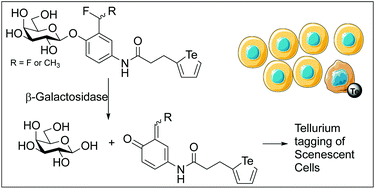A β-galactosidase probe for the detection of cellular senescence by mass cytometry†
Abstract
Mass cytometry (MC) is a powerful method that combines the cellular resolution of flow cytometry with the isotopic resolution of inductively coupled plasma mass spectrometry (ICP-MS). This combination theoretically allows for the simultaneous quantification of >80 different parameters at the single cell level, in turn allowing for the deep profiling of heterogeneous cell populations. The majority of available reagents for MC are antibodies labeled with heavy metal isotopes, allowing for the quantification of static biomarkers. To complement these reagents, we aim to develop small molecule reporters of cellular metabolism that are compatible with MC. Here we report a probe of β-galactosidase activity capable of detecting cellular senescence. The galactoside probe contains a tellurophene reporter group and, when hydrolyzed, generates a quinone alkide. This reactive alkylating agent forms covalent tellurophene bearing conjugates with local nucleophiles, allowing for the quantification of β-galactosidase activity in individual cells. Difluoromethyl and monofluoroethyl quinone alkide generating warheads were examined for their activities and compared in vitro and in vivo. We showed that the difluoromethyl derivative gave higher tellurium labelling in vitro and that the quinone methide was more reactive towards thiols than amines. In vivo the difluoromethyl derivative successfully labeled senescent cells with comparable selectivity to the commonly used fluorescent senescence probe C12FDG.



 Please wait while we load your content...
Please wait while we load your content...